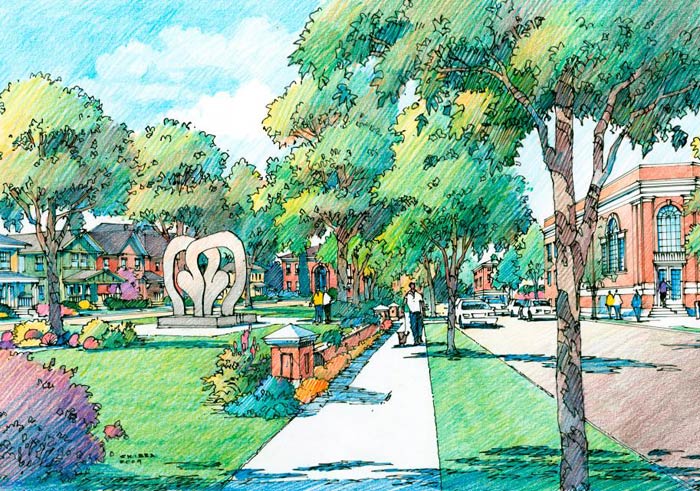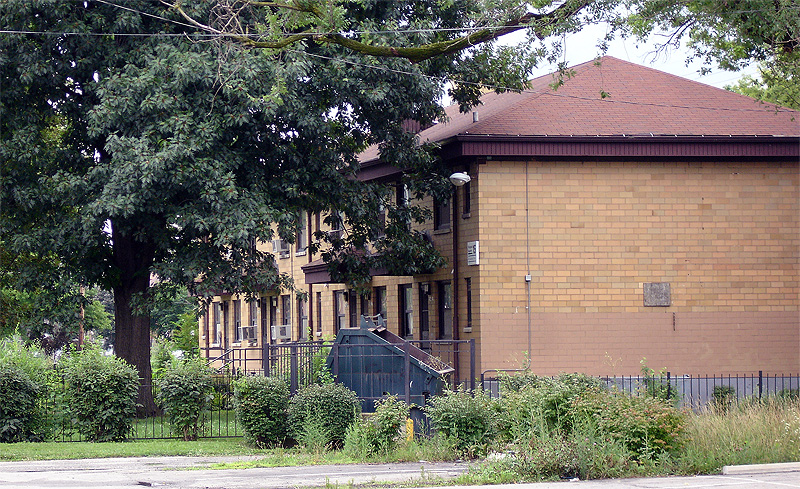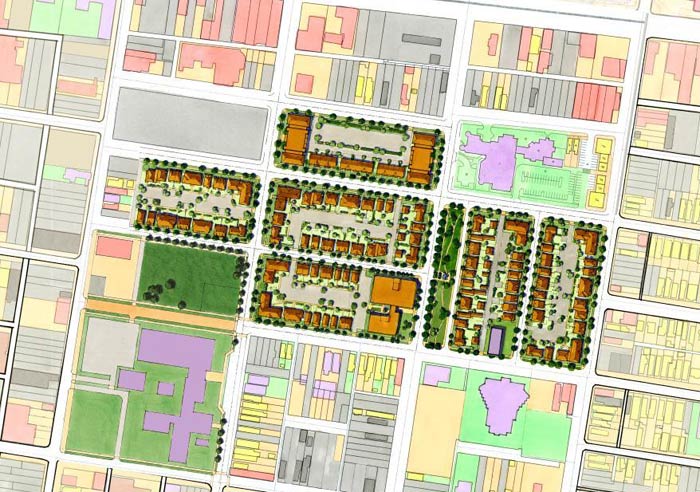
Officials from Metro Louisville, the Metro Housing Authority (LMHA), and the U.S. Department of Housing and Urban Development (HUD) gathered in May to announce funding for Louisville’s third HOPE VI development on the site of the current Sheppard Square housing project in the Smoketown-Jackson neighborhood. After a failed attempt last year, LMHA was awarded a $22 million federal grant that will jump start the estimated $167 million redevelopment, with additional funding expected to come from public and private sources.
Long in planning, the future of Sheppard Square will resemble the Park DuValle neighborhood or the nearby Liberty Green, with traditional-styled, market-rate and subsidized residential buildings built under the guidelines of New Urbanism.

Sheppard Square, built in 1943, currently covers 16 acres with 326 units just south of East Broadway. Tim Barry, executive director at LMHA, said the first step in redeveloping the area is to relocate the remaining tenants—expected to be complete by the end of the year—and then begin demolition in early 2012. Infrastructure construction could begin as soon as the end of next year, but Barry said he is working on a five-year time frame for the federal grant, so progress won’t be far off.
Arranged in Louisville’s typical 20th-century barracks-style layout, Sheppard Square creates an alienating urban experience that’s out of character with the mixed-use neighborhood predominated by shotgun houses. The new plan—which won’t be called Sheppard Square but will include homage to the namesake Dr. Sheppard—brings single and multi-family buildings back to the street with a central linear park along Hancock Street—dubbed Hancock Green—forming a focal point for the neighborhood. “We always want to build something consistent with the existing architecture,” said Barry.
Planning for the project began over six years ago, said Bernard Pincus, director of development at LMHA. Original concepts were drawn by Pittsburgh-based Urban Design Associates, who also worked on Louisville’s other HOPE VI neighborhoods. Finalized plans call for 345 new units on site including market rate apartments and single-family houses.
As is apparent in the site plan below, Hancock Street will be reopened to traffic—it’s currently cut in half by the metal boxing glove statue (visible in the rendering at the top) which will be relocated to Hancock Green. Roselane Street (originally Rose Lane according to historic maps) will be restored between Hancock and Preston Streets while to the east, Gaddie Street will span Jacob and Lampton Streets, redefining the historic small-scale blocks in the neighborhood.

In an agreement with the Jefferson County Public Schools (JCPS), a recreational area adjacent to Meyzeek Middle School will be located at the southwest corner of the site with one block on Lampton Street closed to auto-traffic. Barry declined to say what the new pedestrian walkway would look like as it’s still underdevelopment with JCPS. The recreational fields would be available for public use.
At Hancock and Roseland streets, the old Presbyterian Community Center (PCC), a grand historic building, will be restored and converted into offices and apartments for the elderly and disabled veterans. “We’re going to do a bang-up job on the old community center,” said Barry. “It’s of great importance to the community.” An addition will be built to the south of the existing structure, which is unfortunately set back from the corner (a result of maintaining sight-lines for motorists Pincus explained).
Between 25 and 30 market-rate, single-family houses will surround the old PCC and Hancock Green, each with its own private garage. Higher density units will be located nearest to East Broadway.
Barry said LMHA is exploring out-parcels as well including the two-story former Duvall Liquor store at the southwest corner of Hancock and Breckinridge streets. The historic building could be converted into apartments, possibly with a retail space on the first floor. Another option is a vacant block to the northwest of Sheppard Square that was once home to the original Hillerich & Bradsby “Louisville Slugger” factory and is still owned by the Hillerich family. Barry said LMHA “would certainly pay homage to the site as the original bat factory.” For now, the main focus remains on the original Sheppard Square footprint.
Among the unique features of the redevelopment are the sustainable components, including green rainwater management systems to help reduce combined sewer overflow, a major problem in Louisville. Sheppard Square represents an increase from measures taken at Liberty Green, said Barry. Pervious pavers will definitely be part of the mix, but he assured us that’s just a start. (We’re hoping for curb-side rain gardens.) Like Liberty Green, every building will be Energy Star rated, but the new development will also be an Enterprise Green Community which takes sustainability to the neighborhood level.
The new Sheppard Square will be a residential development with no planned commercial space, but Barry said the project is intended to spur additional private redevelopment in the surrounding Smoketown-Jackson neighborhood, which has ample potential to bring in a mix of additional uses.



This is a really timely article for me. I’ve spent the last week researching the historical address where my family lived in Louisville. I’m not done yet, but I’m pretty sure that the address where my mother’s family first lived after immigrating from Germany was along Rose Lane (and now long gone since the construction of Sheppard Square). When I learned this I was sadden about the changes… and it makes me a bit happier to see that they are bringing back some historical elements to the area (block size, resotring streets, etc).
This plan is depressing. It is a suburban fantasy on steroids and is a replication of what we have already done and are “comfortable” with. It is not sustainable long term. In 20 years when the newness has worn off this process will be repeated.
This is urban land with the possiblity of true mixed used high density infill. The imediate neighborhood has hundreds of vacant lots and structures that could be used for single family infill.
Ideas: (1) At least one of the old structures should be saved and incorporated into any new development
(2) Consider turning this into a park and buying out the properties between the site and Broadway. Rezone surrounding properties for greater density and commercial use.
I’m questioning the $167 million redevelopment cost of the Sheppard Square housing project. Recently Business First had an article about River Breeze, an 18-acre apartment complex, slightly larger area than Sheppard Square, in the Pleasure Ridge Park area for $10 million. What am I missing?
http://www.bizjournals.com/louisville/print-edition/2011/04/08/10-million-apartment-complex-under.html?page=all
I don’t believe that the proposed is an appropriate scale for an area so near to downtown. This development is just off of Broadway. It is an area that could be anything. With the Hospitals, JCC, professional and Highland emigres. New construction of detached, gabled roof structures installs an artificial and out-of-place edge to downtown. That housing style cannot possibly also incorporate an appreciable number of units of below market-rate housing with the more numerous (and more visible) for sale dwelling units. We have to bring more people into downtown without displacing those who held on to their neighborhood, or those who were installed into an area by earlier plans.
The gaps along Breckenridge Street just east of Meyzeek are slowly filling in with a mix of less intense housing styles, similar in appearance to what remains. At that point you know that you are in Smoketown. A neighborhood with a perceptible character and boundary. If Sheppard Square is now not connected to any neighborhood or district, and is a blank slate for future design, I am sure that we can do something more than artificially recreate – what are those in the picture? – Craftsman bungalows!
I agree with Dan that at least one of the structures should be retained. We can’t pretend that a big part of post war (WWII) housing policy didn’t happen. Those “barracks” first housed returning vets, if I remember correctly, and then served as our own model for warehousing the poor. I think, just as we need to remember river front warehouses for bourbon, we really must remember what we did/do with people. I think a large part of learning from that comes in retaining a tangible memory. That lesson should be reflected in the planning of this area, beyond historical cues but through inclusion. That is not just a boxing glove preventing cut-through traffic.
Please no more parks in Downtown or in Old Louisville. We have more than what we know what to do with now (design, budget, use). I won’t give examples, but most of the spaces don’t relate to the surroundings, surrounding uses don’t spill out on to these spaces, the spaces don’t help to organize or orient the surrounding structures. Interesting niches/pockets between building are nice, the linear park in the Shepard Square concept could be nice for an urban neighborhood. A city/state/fed agency now owns this property. It could have substantial control over the design, use, intensity, phasing, and planning of this well located property: qualities that they have hardly taken advantage of in the concept. Those rare qualities would be given away for nothing if this were converted into a park. Park, swale, and farm urban areas with extreme caution.
If I had 16 acres on the east side of downtown and $100 million to spend, I would do a lot more than build 345 housing units.
It wouldn’t make sense to leave any of the old Sheppard Square buildings. They’re full of lead, unsafe, and unfair to the people who have been living in them. Not only that, but Smoketown/SS residents have had such a crime ridden neighborhood that their kids can’t go outside and really play like most kids do. Its not safe for residents to just go for a jog in their own neighborhood without fear. The playground is usually a ghost town. They don’t have much access to real physical activity. The Hope VI grants have made a dramatic positive difference to the neighborhoods of Park Duvall (remember cotter homes??) and Liberty Green. God forbid they put some green space downtown for residents to feel safe getting some exercise in their own neighborhood. Everyone deserves to be able to do that. It’s pretty basic. ((Nothing could be done to Sheppard Square that could be worse than whats there now)). Its about time!!
It /is/ pretty basic stuff. The LMHA proposed solution to Sheppard Square is pretty basic. Where Park Duvalle was and is an outstanding local/national HOPE VI redevelopment plan, this proposal assumes that the new urbanist solution arrived at, there, is appropriate here. It doesn’t appear to examine the unique setting and circumstances. Just cut and paste the recommendation. Set up the fact finding so that it leads to the same solution as a previous site. Nothing controversial in the result, it just isn’t close to being all that it could be.
Green space in itself does not equal safety, it does not equal increased property value, nor does it equal increased physical activity.
—
I really enjoy this forum. Even though, I often arrive at a dissenting opinion to the articles and views expressed here. I am glad to have a reliable source of development information, and content that examines urban form in Louisville. Great mental exercise.
@nick – I think we have all forgotten that that price tag is also part of the displacement and housing of residents while the project is being built, design, planning, meetings, demolition, construction, (at union wages) and property management. I for one a smoketown resident and property owner am thrilled with the opportunity though, saddened that a larger mixed use, more progressive, out of the box proposal hasn’t been sought…
I believe its a good idea some of those people down there get used to the low paying rent and get comfortable they don’t have to work hard of they don’t want to because they know that their rent will be little to nothing. The projects should be used as a stepping stone. Go to school raise your kids and get out. It’s good for that purpose only. It should not be a way of living forever. Then these young ladies have these young thugs come into their home and sell drugs. Yes they should tare them down. We as young black women need to become more respondable for our actions.